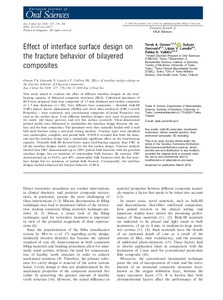Effect of interface surface design on the fracture behavior of bilayered composites
Lassila LV; Vallittu PK; Garoushi S; Omran TA
https://urn.fi/URN:NBN:fi-fe2021042825629
Tiivistelmä
This study aimed to evaluate the effect of different interface designs on the load-bearing capacity of bilayered composite structures (BLS). Cylindrical specimens of BLS were prepared from base composite of 3.5 mm thickness and surface composite of 1.5 mm thickness (n = 80). Two different base composites - flowable bulk-fill (FBF) [smart dentin replacement (SDR)] and short fiber-reinforced (FRC) (everX Posterior) - were evaluated, and conventional composite (G-aenial Posterior) was used as the surface layer. Four different interface designs were used: (i) pyramidal; (ii) mesh; (iii) linear grooves; and (iv) flat surface (control). Three-dimensional printed molds were fabricated to standardize the interface design between the surface and the base composites. The specimens were then statically loaded with a steel ball until fracture using a universal testing machine. Fracture types were classified into catastrophic, complete, and partial bulk. ANOVA revealed that both the material and the interface design had a statistically significant effect on the load-bearing capacity. Flowable bulk-fill showed lower mean load-bearing capacity than FRC in all the interface designs tested, except for the flat surface design. Fracture analysis showed that FRC demonstrated up to 100% partial bulk fractures with the pyramid interface design, but no incidence of catastrophic bulk fracture. By contrast, FBF demonstrated up to 84.6% and 40% catastrophic bulk fractures with the flat interface design but no incidence of partial bulk fracture. Consequently, the interface designs studied enhanced the fracture behavior of BLS.
Kokoelmat
- Rinnakkaistallenteet [19218]
